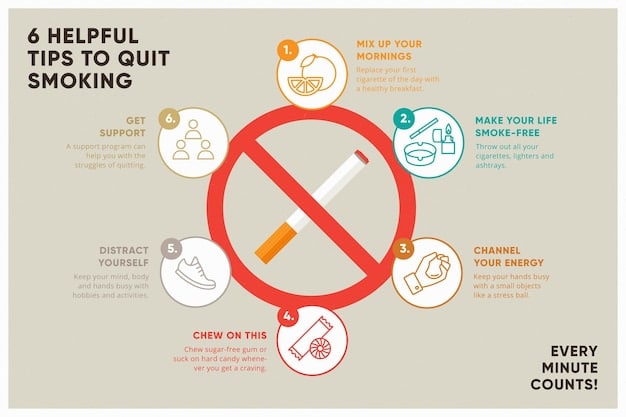FDA E-Cigarette Regulations 2025: What’s New for Public Health

The FDA’s new regulations on e-cigarette marketing and public health in 2025 aim to curb youth vaping by restricting flavored products, enhancing advertising oversight, and requiring more comprehensive health warnings, impacting manufacturers, retailers, and consumers.
The landscape of e-cigarette regulation is constantly evolving, and 2025 promises to be a pivotal year. New regulations from the FDA are set to reshape the e-cigarette market and public health. Here’s what you need to know about the FDA’s new regulations on e-cigarette marketing and public health in 2025.
Understanding the FDA’s Regulatory Authority
The FDA (Food and Drug Administration) has broad authority over the manufacturing, marketing, and sale of tobacco products in the United States. This authority extends to e-cigarettes, which the FDA regulates as tobacco products. The FDA’s regulatory power is crucial in shaping the e-cigarette market and safeguarding public health.
Let’s examine the details of the FDA’s existing authority and its implications for e-cigarette regulation.
Historical Context of FDA Regulation
Initially, e-cigarettes were not explicitly regulated by the FDA. However, the Family Smoking Prevention and Tobacco Control Act of 2009 granted the FDA authority over tobacco products. Over time, the FDA extended its regulatory reach to include e-cigarettes, especially as concerns about youth vaping increased. Key milestones include:
- 2016: The FDA issued a rule extending its tobacco authority to include e-cigarettes, cigars, and hookah tobacco.
- Ongoing: The FDA has since focused on premarket review, marketing restrictions, and enforcement actions against illegal products.
Key Aspects of FDA’s Regulatory Powers
The FDA’s regulatory powers over e-cigarettes encompass several crucial areas:
- Premarket Review: Manufacturers must obtain FDA authorization before introducing new e-cigarette products to the market. This process involves submitting scientific evidence that the product is appropriate for the protection of public health.
- Manufacturing Standards: The FDA sets standards for the manufacturing, packaging, and labeling of e-cigarettes to ensure product safety and quality.
- Marketing Restrictions: The FDA regulates the advertising and promotion of e-cigarettes, particularly to prevent youth-targeted marketing.
- Enforcement: The FDA has the authority to take enforcement actions against companies that violate regulations, including issuing warning letters, seizing illegal products, and seeking injunctions.

Through these powers, the FDA aims to balance the potential benefits of e-cigarettes as a harm reduction tool for adult smokers with the need to protect youth and prevent nicotine addiction. Understanding these regulatory foundations is essential for grasping the significance of the upcoming changes in 2025.
In conclusion, the FDA’s regulatory authority is the backbone of e-cigarette control in the US. As we approach 2025, these powers will be leveraged to implement new regulations designed to protect public health more effectively.
Major Changes Coming in 2025
Several significant changes are anticipated in 2025 as the FDA aims to strengthen its oversight over e-cigarettes. These changes span various facets of the industry, from marketing to product standards, and are designed to mitigate the public health risks associated with vaping.
Let’s explore what those changes might entail and how they could reshape the e-cigarette landscape.
Restrictions on Flavored E-Cigarettes
Flavored e-cigarettes have long been a point of contention due to their appeal to youth. The FDA is expected to implement stricter regulations on flavored products, potentially banning or limiting the availability of certain flavors that are particularly attractive to young people. The rationale behind this is to reduce the initiation of vaping among adolescents.
Enhanced Oversight of Marketing and Advertising
Marketing and advertising practices of e-cigarette companies are also under increased scrutiny. The FDA is likely to introduce measures that restrict advertising channels and content that appeal to underage individuals. This includes limitations on social media marketing, influencer endorsements, and promotional activities that target youth.
Stricter Health Warning Requirements
To better inform consumers about the potential health risks of e-cigarettes, the FDA is considering more comprehensive and prominent health warnings on e-cigarette packaging and in advertising materials. These warnings may include detailed information about nicotine addiction, respiratory issues, and other potential health consequences. Increased label and warning visibility and comprehensiveness is expected to better inform consumers and deter use.

These impending changes underscore the FDA’s commitment to addressing the public health challenges posed by e-cigarettes. By focusing on flavors, marketing, and health warnings, the agency aims to strike a balance between providing alternatives for adult smokers and protecting the younger generation from nicotine addiction.
In summary, the major regulatory shifts in 2025 reflect a determined effort by the FDA to control the e-cigarette market and safeguard public health. These changes are poised to have a significant impact on both the industry and consumers.
Impact on E-Cigarette Manufacturers
The new regulations coming in 2025 will significantly impact e-cigarette manufacturers. Compliance with these rules will require substantial adjustments to their business models, product offerings, and marketing strategies.
Next are key areas where manufacturers will feel the impact of the FDA’s regulations.
Compliance Costs and Product Modifications
Manufacturers will face increased compliance costs as they adapt to new product standards and marketing restrictions. This could involve reformulating products to meet flavor restrictions, redesigning packaging to accommodate enhanced health warnings, and restructuring advertising campaigns to comply with stringent regulations. Smaller manufacturers may find these costs particularly burdensome.
Reduced Market Access
Limitations on flavored e-cigarettes and stricter marketing rules could lead to a reduction in market access for some manufacturers. Companies that heavily rely on flavored products or youth-targeted marketing may experience significant revenue declines. Gaining FDA authorization for new products will become even more crucial for survival in the market.
Innovation and Adaptability
To thrive under the new regulatory environment, manufacturers must innovate and adapt. This includes developing new product formulations that comply with flavor restrictions, exploring alternative marketing strategies that target adult smokers without appealing to youth, and investing in research to demonstrate the potential harm reduction benefits of their products.
- Innovate new product formulations that comply with flavor restrictions.
- Target adult smokers without appealing to youth for alternative marketing strategies.
- Invest in research to demonstrate the potential harm reduction benefits of their products.
Manufacturers that embrace innovation and prioritize compliance are more likely to navigate the challenges posed by the new FDA regulations successfully. This proactive approach will be vital for maintaining a competitive edge and contributing to a more responsible e-cigarette industry.
Ultimately, the impact on e-cigarette manufacturers will depend on their willingness and ability to adapt to the changing regulatory landscape. Those who prioritize compliance and innovation will be better positioned to succeed in the long term.
Effects on Retailers and Distributors
Retailers and distributors of e-cigarettes will also experience significant changes as a result of the FDA’s new regulations in 2025. These businesses will need to adapt their inventory, marketing practices, and sales strategies to comply with the updated rules.
Let’s investigate the specific ways these regulations will affect retailers and distributors.
Inventory Management Challenges
Restrictions on flavored e-cigarettes could lead to inventory management challenges for retailers. They may need to clear out existing stock of prohibited flavors and adjust their product offerings to focus on compliant alternatives. This could result in financial losses due to unsold inventory and the need to invest in new product lines.
Changes in Marketing and Sales Practices
Retailers will need to modify their marketing and sales practices to align with new advertising restrictions. This includes removing promotional displays that appeal to youth, implementing stricter age verification procedures, and ensuring that marketing materials comply with FDA guidelines. Online retailers will face additional challenges in verifying the age of customers and preventing underage sales.
Training and Compliance
To ensure compliance with the new regulations, retailers and distributors will need to invest in training programs for their employees. These programs should cover topics such as age verification, marketing restrictions, and product compliance. Proper training is essential for avoiding violations and maintaining a good standing with regulatory authorities.
Adapting to these changes will require a proactive approach from retailers and distributors. Those who prioritize compliance, invest in employee training, and adjust their business practices accordingly will be better positioned to thrive in the evolving e-cigarette market.
In conclusion the new FDA regulations will present both challenges and opportunities for retailers and distributors. By embracing compliance and adapting their business practices, these businesses can continue to serve adult smokers while minimizing the risk of youth vaping.
Implications for Public Health
The primary goal of the FDA’s new regulations on e-cigarettes is to protect and improve public health. These regulations aim to reduce youth vaping rates, prevent nicotine addiction, and minimize the potential health risks associated with e-cigarette use.
Next are several ways in which these regulations could impact public health.
Reduced Youth Vaping Rates
By restricting flavored e-cigarettes and limiting youth-targeted marketing, the FDA hopes to reduce the appeal of vaping products to underage individuals. Studies have shown that flavors play a significant role in attracting young people to e-cigarettes, and stricter regulations could lead to a decline in youth vaping rates. The reduction of youth nicotine addiction as well as potential lung damage are expected outcomes.
Decreased Nicotine Addiction
Comprehensive health warnings on e-cigarette packaging and in advertising materials could help consumers better understand the risks of nicotine addiction. By increasing awareness of these risks, the FDA hopes to discourage e-cigarette use and prevent new cases of nicotine dependence.
Potential Health Risks Mitigation
The FDA’s regulations also aim to minimize the potential health risks associated with e-cigarette use. This includes setting standards for product manufacturing, conducting premarket reviews to ensure product safety, and monitoring adverse events related to e-cigarette use. These efforts are designed to protect consumers from harmful ingredients and defective products. If defective products are taken out of the market and manufacturing standards are tightened, it is expected that consumers will benefit.
The success of these regulations in improving public health will depend on effective implementation and enforcement. Continued monitoring of e-cigarette use patterns and health outcomes is also essential for evaluating the impact of the FDA’s actions.
In summary, the FDA’s new regulations have the potential to significantly improve public health by reducing youth vaping rates, decreasing nicotine addiction, and mitigating the potential health risks associated with e-cigarette use.
Future Outlook and Potential Challenges
Looking ahead, the e-cigarette market is expected to undergo further transformation as the FDA’s new regulations take effect and the industry continues to evolve. However, several challenges could impact the effectiveness of these regulations.
Let’s discuss the future outlook and potential challenges associated with e-cigarette regulation.
Evolving Products and Technologies
The e-cigarette industry is known for its rapid innovation, with new products and technologies constantly emerging. This poses a challenge for regulators, who must stay ahead of these developments to ensure that regulations remain effective. For example, new types of vaping devices or nicotine delivery systems could circumvent existing regulations.
Enforcement Challenges
Enforcing the new regulations will require significant resources and coordination among federal, state, and local agencies. Challenges may include monitoring online sales, inspecting retail establishments, and preventing the illegal importation of e-cigarette products. Without strong enforcement, the impact of the regulations could be limited.
Industry Opposition and Legal Challenges
The e-cigarette industry may respond to the new regulations with opposition and legal challenges. Companies may argue that the regulations are overly burdensome or that they infringe on their constitutional rights. Legal battles could delay or weaken the implementation of the regulations.
- Legal battles could delay or weaken the implementation of the regulations.
- The industry may argue that the regulations are overly burdensome or infringe on their constitutional rights.
Despite these challenges, the FDA remains committed to its mission of protecting public health. By carefully monitoring the e-cigarette market, adapting regulations as needed, and working collaboratively with stakeholders, the agency can maximize the effectiveness of its efforts.
In conclusion the future of e-cigarette regulation will depend on addressing these challenges and adapting to the evolving landscape. With a proactive and collaborative approach, the FDA can continue to safeguard public health while allowing adult smokers access to potentially less harmful alternatives.
| Key Point | Brief Description |
|---|---|
| 🚭 Flavor Restrictions | Limits on flavored e-cigarettes to reduce youth appeal. |
| 📢 Marketing Oversight | Enhanced control over e-cigarette advertising and promotion. |
| ⚠️ Health Warnings | More comprehensive health warnings on packaging. |
| 🔬 Product Standards | Stricter manufacturing and safety standards for e-cigarettes. |
Frequently Asked Questions
▼
The main focus is to protect public health, particularly by reducing youth vaping and preventing nicotine addiction. This involves stricter controls on flavored e-cigarettes and marketing practices.
▼
Manufacturers will face increased compliance costs, potential market access reductions, and will need to innovate to adapt to new product and marketing standards to stay competitive.
▼
Retailers will need to manage inventory carefully due to flavor restrictions, modify marketing practices to comply with advertising rules, and invest in employee training for compliance.
▼
The FDA is expected to implement stricter rules on flavored e-cigarettes, potentially banning or limiting the availability of certain flavors. The exact extent of these restrictions remains to be seen.
▼
Health warnings are likely to become more prominent and comprehensive, providing detailed information about the risks of nicotine addiction, respiratory issues, and other potential health consequences.
Conclusion
In summary, the FDA’s new regulations on e-cigarette marketing and public health in 2025 are poised to significantly reshape the e-cigarette landscape. By focusing on reducing youth vaping, preventing nicotine addiction, and minimizing potential health risks, these regulations aim to protect public health while providing adult smokers with potentially less harmful alternatives.





